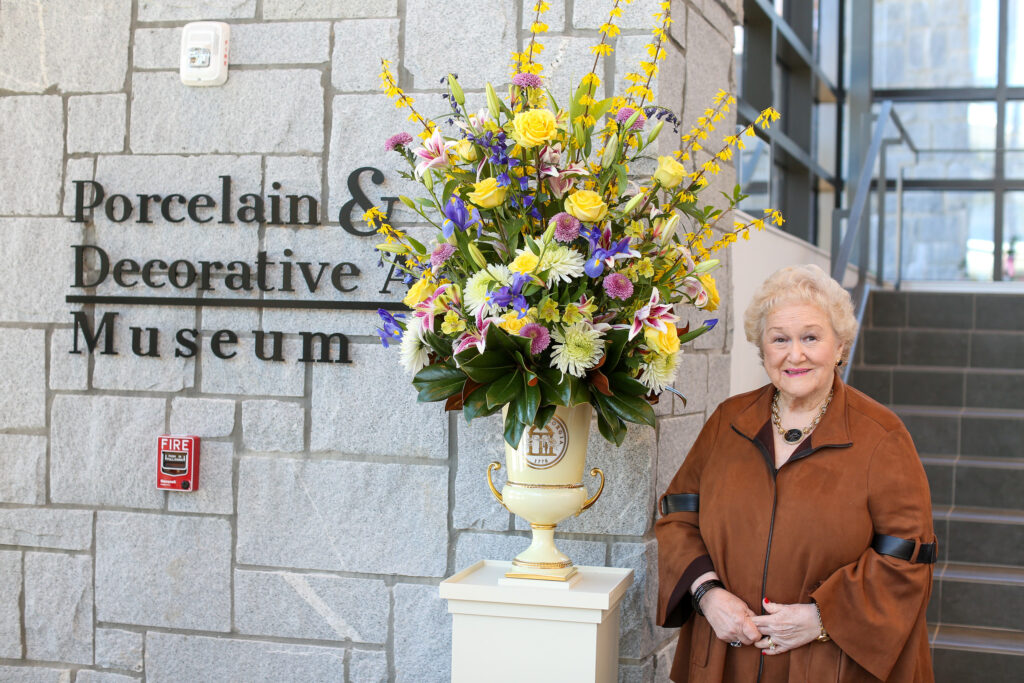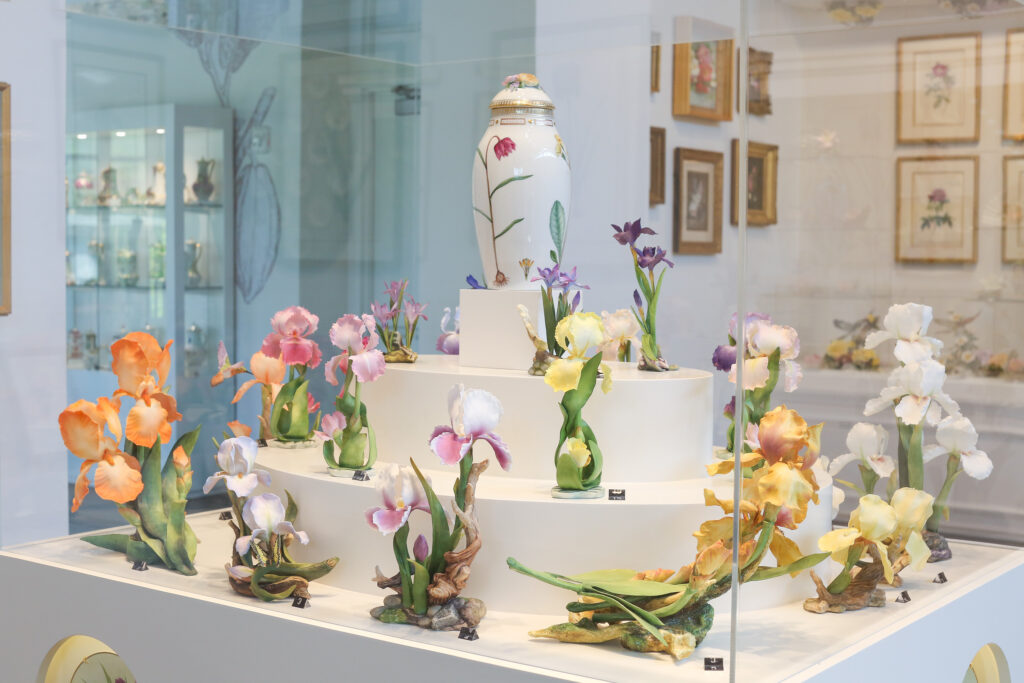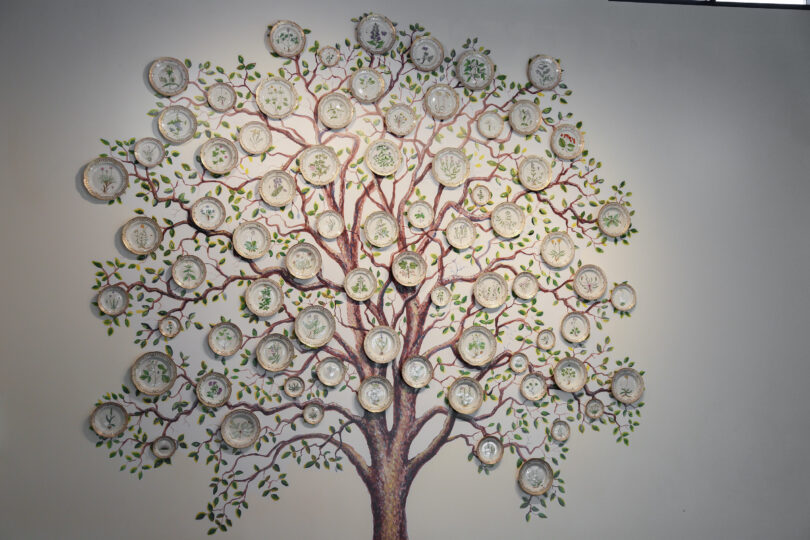The newest tree at the State Botanical Garden of Georgia needs no water or sunlight. Its 75 blossoms are made of kaolin and bone china. They bear images of Danish botanicals, meticulously reproduced from folio-sized illustrations drawn in the late 1700s and early 1800s.
The Tree of Life is on a wall of the main gallery at the Porcelain and Decorative Arts Museum.
The building houses more than 1,000 pieces of porcelain and botanical art, including drawings, paintings and bound books of illustrations of the flora of Denmark, donated by Deen Day Sanders, a long-time supporter of the State Botanical Garden.
“What we’re doing is different than how typical art museums would approach displaying these items,” said Jenny Cruse-Sanders MS ’97, PhD ’03, director of the State Botanical Garden of Georgia. “We are presenting these items in context with natural history, biology and nature. So, the idea is to showcase what we can learn about our world by observing these decorative arts.”
The museum, part of the new Center for Art and Nature, will allow the garden staff to further extend educational, cultural enrichment, research and experiential learning opportunities for faculty and students, centered on the relationship of art and the natural world.
The State Botanical Garden, a UGA Public Service and Outreach unit, was established more than 50 years ago as a living laboratory to support scientific education. The garden is a place of discovery, providing resources to faculty and students but also to members of the public that visit from near and far.

Deen Day Sanders has served as president of the Garden Club of Georgia and president of National Garden Clubs. The Porcelain and Decorative Arts Museum holds significant items donated from her collection, and she is the sole donor to fund its establishment.
Gardens appear to cascade outside the windows of the museum gallery where the Dorothy Doughty birds are exhibited—one of the largest collections of Doughty’s birds on public display. Exhibiting porcelain in a botanical garden is as natural as exhibiting antique tea roses. Throughout the new museum there are countless examples of porcelain inspired by botanical exploration and scientific studies in botanical gardens and nature settings.
Flora Danica, an encyclopedic study of the original flora of Denmark, led to more than a century of research documenting the history of the flora, accompanied by detailed scientific drawings of each plant. In the late 1700s, the Prince of Denmark commissioned a porcelain collection that mirrored the detailed illustrations, some now displayed on the tree of life.
“Those pieces weren’t necessarily meant to be beautiful, they were intended to strike conversations,” Cruse-Sanders said. “First created during the age of enlightenment, the highest form of art were those meticulous reproductions of the discoveries being made in nature.”
Natural light flows through the museum, illuminating the ceramic figurines, plates, tea sets, chocolate pots and urns. One case holds more than a dozen iris figurines, in yellow, purple, white, orange and pink, several by artist Diane Lewis.
“If you know anything about me, you’re going to know very quickly why that means a lot to me,” Sanders said. “The iris is my favorite flower and I love butterflies.”
As an apprentice flower maker at the Royal Worcester porcelain studio, Lewis focused on delicate florals made from clay—colorful roses, irises, orchids, wildflowers, which would become part of the the studios’s most popular series, a collection of American birds. Lewis studied under Dorothy Doughty, whose birds were highly collectible.
Lewis went on to establish Connoisseur of Malvern, a porcelain factory in England, which was active until the late1900s.
More than 50 of Lewis’ sculptures, including the Deen Day iris, Deen Day lily and Deen Day camelia, are displayed in the museum.
“I saw it in Waterford,” Sanders said. “Then I started seeing her work over here in the United States and began my collection.”
Highlighting the influential work of another female artist, Sanders points out a master charger plate made in China, circa 1735-1740, using underglazed cobalt blue on white porcelain with gilding around the edges. The iris and butterfly design on this piece is based on the scientific illustrations of Maria Sibylle Merian, a German-born naturalist and artist in the late 1600s and early 1700s.
While her works are watercolor paintings or engravings, many have been used as models for patterns on porcelain dishes, vases, tea seats, and more, some even on pieces of porcelain from Meissen, Germany, where the first European porcelain factory was launched in 1710.
At the time the Meissen factory was founded, Europeans were enthralled with Chinese porcelain. It was pure white, and exceeded the quality of any other porcelain in the worl.
The Germans were determined to create their own porcelain out of Saxon clays, using the trade skills of miners and smelters. But they couldn’t make the white ceramics from the red clay, so they substituted kaolin, a chalky white substance that was locally mined.
Kaolin is native to Georgia, mined near Sandersville (locally known as the kaolin capital of the world) and exported throughout the U.S. and the world for use in cosmetics and medicines, as a paper coating, and in the manufacturing of china and pottery.
One of Sanders favorite pieces, a church (right) from the Porcelain Manufactory in Meissen, Germany is on display at the museum. Believed to be one of only several in the world, it sat for years in Sanders’ Cashiers, N.C., home, a symbol of her Christianity.
“This church is very dear to me because of my faith,” Sanders said. “You don’t get anything on your own. If somebody helps you along the way, you need to give back. If it’s been given to you, you need to share it.”
Sanders was one of the State Botanical Garden’s earliest supporters, there at its beginning She served as president of the Garden Club of Georgia, and later president of National Garden Clubs, Inc. and vice president of the World Association of Floral Artists.
Her interest in flowers, and porcelain began as a child.
“I had a china tea pot and cups that an uncle, who was in the navy, brought me from China,” she said. “I loved to play with it along with my little dolls. I’ve always like dainty, pretty things. So, when I got married, I started collecting different pieces of porcelain that I thought were pretty and when I could afford to have a serious buying interest, I did and I began collecting fine and rare porcelain.”
This church is very dear to me because of my faith. You don’t get anything on your own. If somebody helps you along the way, you need to give back. If it’s been given to you, you need to share it.” — Deen Day Sanders, the sole donor supporting the establishment of the Porcelain and Decorative Arts Museum at the State Botanical Garden of Georgia
She found many pieces during her travels, or at auctions. Virginia White, Sanders interior designer, found some in antique stores and commissioned others on Sanders’ behalf. Sanders husband, Jim, commissioned Diane Lewis to create Deen’s Iris as a Christmas gift for his wife in 2019.
“The State Botanical Garden is absolutely the most natural place in the world to display the porcelain and decorative arts that Deen collected over the years because they reflect her interests,” Cruse-Sanders said. “And Deen has had a lifelong passion for botanical gardens, flowers, butterflies and the beauty she sees in nature.
One of her major displays is a collection of coffee, tea and chocolate serving sets. These are all produced from plants around the world that had to be cultivated, propagated, produced and served. The museum tells these and many more stories of the connection between plants and decorative arts.
“I want nature to be interpreted in word and example in this museum,” Sanders said. “I want visitors to know that there’s a botanical component in everything you do. I believe that art captures and imitates nature. With this museum we will be able to demonstrate that correlation.”









